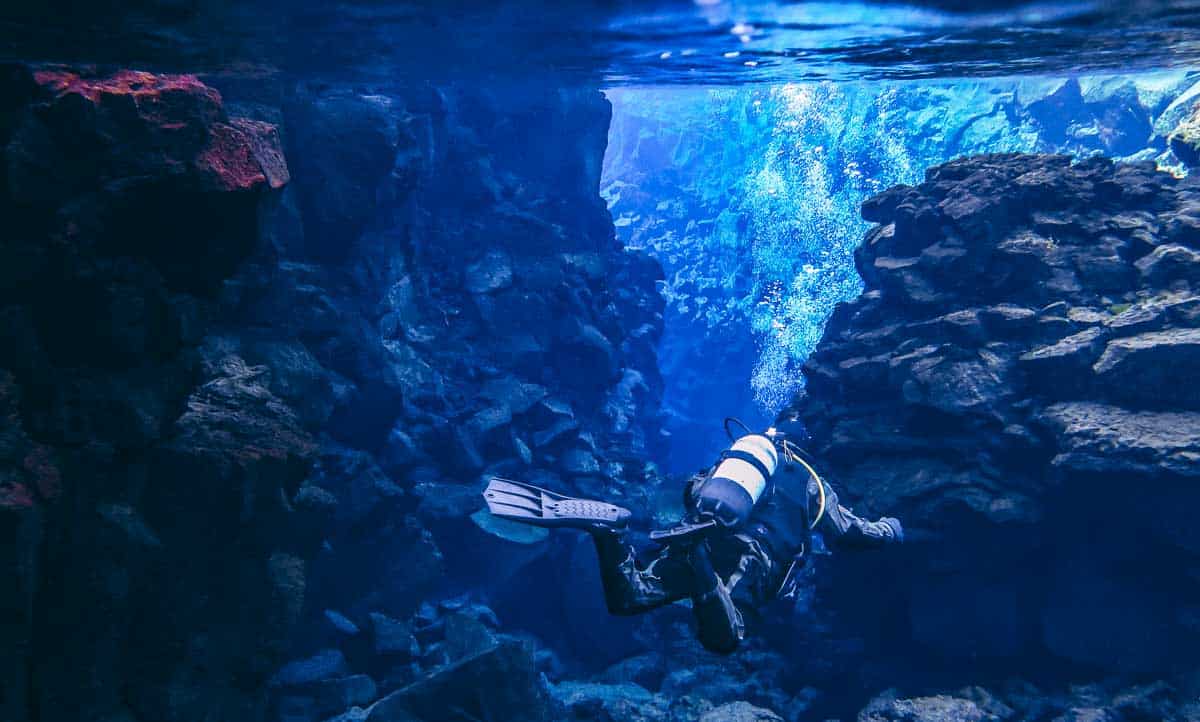Scuba diving is a physically challenging activity that requires your whole body to work in perfect sync. It’s an activity that can get challenging especially when the water temperature drops. Scuba diving can become uncomfortable and even unsafe for you if you don’t prepare yourself properly for it. To have a safe and enjoyable scuba diving experience, you need the right kind of dive suit or wetsuit to keep you warm and comfortable in the water. Scuba dry suits are designed with divers in mind as they are specifically tailored to withstand the challenges of dry, or hot, water diving. They significantly reduce moisture on your skin while also increasing your thermal protection against cold water.
There are lots of different types of wetsuits available on the market these days; however, most of them cannot be used for scuba diving unless they are modified or made from specific materials. The following article will help you understand what exactly a scuba dry suit is, its pros and cons, and how to choose one that suits your needs best.
ALL THE SCUBA DRY SUITS THAT WE TESTED
AQUALUNG Fusion Sport AirCore Drysuit
General Impression
The Aqualung fusion sport combines Aqualung’s Drycore technology with an abrasion resistant lycra skin. The fact that this Aqualung scuba dry suit is a fusion scuba dry suit means that the Drycore material inside is oversized. This means your movement is rarely limited with the outer spandex skin holding everything together. This scuba dry suit is extremely lightweight and compact enough to fit into most luggage. It has a built-in warm neck providing adequate protection and the cuff technology enables silicone seals to be easily replaced without sending the scuba dry suit off for repair. The scuba dry suit also has PU coated knees to provide excellent abrasion resistance. The scuba dry suit comes with adjustable suspenders to keep everything in position on the surface. Most Aqualung dry suits are outstanding but the added fact that this is a fusion scuba dry suit at such a good price makes it excellent value for money.
Specifications
BRAND: AQUALUNG
COMPETENCY: Entry
PROS
- Heavy-duty lycra Skin
- AirCore breathable layer
- YKK military grade brass dry zipper
- PU coated knees
CONS
- Pricey, but worth it
HOLLIS Neotek
General Impression
It’s technically a semi-drysuit, but it’s nevertheless a high-quality one. The Neotek from Hollis has a special 8/7/6mm mix of compression resistant and super stretch Neoprene. The inside is made from Hollis’ proprietary “ThermaSkin” inner layer for added comfort and thermal protection. The Neotek has a neck dam with an innovative horizontal zipper across the shoulders. Two deep pockets on both sides prove ideal for carrying accessories and diving tools. The neck, wrist, and ankles also come with internal dams for added waterproofness.
Specifications
BRAND: HOLLIS
COMPETENCY: Entry
PROS
- ThermaSkin on the inside
- 8/7/6mm mix of compression resistant Neoprene
- External neck dam as well as internal dams on neck wrist and ankles
CONS
- Sizing inconsistent
O'NEIL Men's Boost 300 g Drysuit
General Impression
The O’Neil Men’s Boost 300 g scuba dry suit is made from durable, abrasion-resistant nylon. It’s a baggy style scuba dry suit however it features latex wrist and ankle seals to ensure no water gets in. The neck seal is made from neoprene making it sit comfortably on the skin and causing no chafing. It has a waterproof horizontal zip in the back and built-in suspenders that make getting in and out of it a breeze.
Specifications
BRAND: O’NEIL
COMPETENCY: Beginner
PROS
- 3 layer breathable nylon shell
- Latex seals around the wrists ankles
- Neoprene around the neck
CONS
- Tight neck
MOOKTA Drysuit
General Impression
This scuba dry suit from Mookta uses a new 3 layer technology and special coating to ensure maximum waterproofness and breathability. The neck and wrist parts have waterproof latex seals to ensure no water comes in, but also that it fits comfortably. Additionally, these parts have a neoprene layer to make them durable and comfortable with no unnecessary chafing. The socks are also made from neoprene. The design makes it easy to put on and take off, but also allows for more freedom in movements.
Specifications
BRAND: MOOKTA
COMPETENCY: Intermediate
PROS
- 3 layer technology and special coating
- Waterproof latex seals around neck and wrists
- Neoprene socks and neoprene layer on neck and cuffs
CONS
- Semi-dry suit
GILL Drysuit
General Impression
The Gill scuba dry suit is specially designed with a XPLORE 3 layer material. It’s durable, waterproof and breathable at the same time. The cuffs and neck area are made from glideskin to ensure a snug watertight fit. It features a waterproof YKK zipper across the chest and pocket for accessories and tools. The knees and the bottom area are reinforced with fabric for added durability.
Specifications
BRAND: GILL
COMPETENCY: Beginner
PROS
- XPLORE 3 layer material
- Glideskin on neck and cuffs
- Reinforced knees and bottom
CONS
- Sizes are larger than normal
NRS Pivot Men's Drysuit
General Impression
The NRS Pivot Men’s scuba dry suit is a combination of great and durable materials. The outer shell is made of 4 layer Eclipse and Nanosphere with DWR finish and the neck and splash collar are covered in latex and neoprene. The scuba dry suit is intended to keep you dry and protect you against the elements without compromising your mobility. It comes in two different colors, blue and olive green and 4 different sizes ranging from S to XXL.
Specifications
BRAND: NRS
COMPETENCY: Intermediate
PROS
- 4 layer Eclipse and Nanosphere with DWR finish
- Neck and splash collar made from latex and neoprene
CONS
- No neutral color options
SCUBAPRO EverTech Dry Breathable
General Impression
The Scuba EverTech Dry Breathable is a trilaminate scuba dry suit that has a fascinating breathable material that dries uncommonly quickly. This material allows heat and evaporation to escape whilst also keeping water out during a dive. The new Si Tech ring system can be found on both wrist and neck seals and allow for the quick replacement of faulty or broken seals at a dive site. Scubapro also offers silicone seals if you are allergic. The two cargo pockets are equipped with D-rings, high-security over-flaps and Velcro closures. A hook is even provided on the right-thigh utility pocket for attaching a hood. It is a super lightweight scuba dry suit that will weigh in at about the same as a 3mm wetsuit. It also has a front entry telescopic design, with a rotational inflator valve. It is simply a well-designed, great value-for-money, overall purchase.
Specifications
BRAND: SCUBAPRO
COMPETENCY: Intermediate
PROS
- Breathable trilaminate design
- Si-Tech seal system for wrist and neck
- Warm neck collar
- Two large cargo pockets
CONS
- Sizing inconsistent
STOHLQUIST EZ Drysuit
General Impression
The Stohlquist EZ scuba dry suit is made from their proprietary 4 layers Twin Sensor fabric. The neck part is made from super-stretch neoprene while the wrist parts are made from soft neoprene with a Duraseal latex. For added durability and protection, the knees and bottom part are reinforced. While not the cheapest of options, it’s certainly a great price for value.
Specifications
BRAND: STOHLQUIST
COMPETENCY: Beginner
PROS
- Opening on the chest for easy putting on and taking off
- MasterSeal zippers
- Duraseal latex on neck and wrists
- Knees and bottom reinforced
CONS
- Hard to get ahold of
SCUBAPRO Everdry 4 Men's Drysuit
General Impression
The smartly designed neoprene suit by Scubapro is a Reverse entry scuba dry suit that is fully covered in compressed 4mm neoprene. The neoprene creates very limited buoyancy underwater and the drysuit’s reflective ‘S’ logos are a refreshing look at the standard scuba dry suit style. The scuba dry suit comes with a protective neck seal and neoprene wrist seals. There is a Si Tech inflation valve and auto dump system as well as a single thigh pocket of reasonable size. The reflective S is situated on the chest, arms, and back of the legs and is a great added feature. The suit comes with a protective lining on the knees and a sock system for the feet. The sock system allows the scuba dry suit to be easily turned inside out, making it easy to dry out. Built-in suspenders on the inside make the suit easy to don and doff. All in all, it is a brilliant, affordable, and durable scuba dry suit.
Specifications
BRAND: SCUBAPRO
COMPETENCY: Beginner
PROS
- Protective neck seal
- Reflective S logo
- Highly durable compressed neoprene
- Built in suspenders
CONS
- Semi-dry suit
HOLLIS DX 300X Dry Suit with Neoprene Socks
General Impression
The DX-300X is a scuba dry suit that was designed by technical divers, for technical divers. Well-engineered resistance to tears (300N), puncture, and abrasion are major highlights of this incredibly durable piece of gear. This is managed with the heavy duty Cordura Ripstop outer layer, 12 middle layers of Butyl Mass creating a chemical atmosphere, and a silk inner lining. The newest addition to the Hollis exposure line ensures you are comfortable, free to move, and tough as nails. The suit utilizes the celebrated SiTech silicone seals at the neck and wrist, while the diagonal YKK zipper at the front makes it one of the easiest dry suits on the market to get on and off. The suit also notably includes 5mm neoprene knee pads, chest mount inflation, and two sizable below thigh pockets.
Specifications
BRAND: HOLLIS
COMPETENCY: Entry
PROS
- Incredibly light
- Unique trilaminate material designed and tested by technical divers
- Knee pads, Velcro pockets, Silicone seals
- ‘Bonded for life’ seams
- Easy to get on and off
CONS
- Hard to get ahold of
BEST SCUBA DRY SUITS
Buyer's Guide
A cold water scuba dry suit can vary enormously. From what material? Boots or socks? To what type of seal is best? The questions for first-time scuba dry suit buyers are endless. That is why we have included below the most frequently asked questions for first-time scuba dry suit buyers making up our most comprehensive guide to drysuits yet.
Which material should I choose?
Neoprene drysuits are thicker and far better at insulating your body heat, unlike other drysuits. The material is often squashed giving them less of an effect on buoyancy and as they are so thick, neoprene drysuits tend to be better at maintaining temperature.
Membrane drysuits – also known as shell or laminate drysuits – are effectively just the outermost layer of a drysuit. They do not retain any warmth but are far lighter and easier to pack. These suits are ideal if you are looking to dive in varied water temperatures as most of the temperature of the suit is maintained from the undergarments worn.
Fusion drysuits are a unique product. They are a combination of two drysuits in one. The suits are more flexible and more streamlined. They provide the most flexible suit on the market. An oversized scuba dry suit core adds additional flexibility, whilst the hardy outer skin is built for environmental resistance. The outer skin is made from a host of materials varying from neoprene to Kevlar.
BEST SCUBA DRY SUITS
FAQs
1. Front entry or back entry?
Front entry scuba dry suits are easy to get into. They normally have a diagonal zip going from thigh to shoulder and can be put on without the aid of a buddy. Despite being easy to get into however the opening is often not as spacious as back entry scuba dry suits. Back entry scuba dry suits have a zipper across the back of the shoulders. These are easier to get into, but you will still need your dive buddy to assist you in getting in and out.
2. Which type of seal is the best?
Latex seals are flexible and cheap to replace; however, they are also rather easy to tear. Remember not to pull too hard on the latex when entering the scuba suit. Intuitively, they cannot be used by anyone with latex allergies. Lastly, they are known to stretch and degrade over time.
Neoprene seals are thicker and tougher than latex on the outside. The inside glide skin, however, is more fragile so do handle it with care. Although they provide even pressure against your body, they cannot be used with dry gloves and do not stretch as easily as other seals. Silicone seals cannot stick to anything and thus require a ring system. They are easily replaceable and do not react to UV as much as neoprene or latex. They provide an excellent seal but are very fragile, so care is needed when trying to put them on.
3. What do all these valves do?
Chest inflation valves place air into the scuba dry suit. You can get a rotational inflation valve however these tend to be more expensive than the fixed valves.
Auto dump valves allow excess gas to escape. If you twist them to the left or right, you can normally change the amount of air that can escape from the valve. You can also press the valve in to increase the amount of air leaving the valve as well.
Cuff dumps are simple one-way valves that allow gas to vent out. Although easier to use than a shoulder dump they can often let water in on the surface.
Pee valves are normally an additional extra. Pee valves allow you to go to the toilet during a dive. They are rather simple for men but much more complicated for women.
4. What extra add-ons come with a scuba dry suit?
Thigh pockets are handy pockets on the sides of the thigh. These are useful for keeping in equipment and normally have a bungee cord for attaching certain items.
Warm necks are simple neoprene covers that cover neck seals that trap water in front to keep you warm. They also have a hole at the bottom for the water to drain from.
Braces are found inside the suit. They hold it up when you are walking around on the surface, so you can take the top half of the scuba dry suit down and remain cool.
Built-in undersuits are only currently found on the Waterproof DX1 drysuit but are relatively self-explanatory.
Cuff guards are silicone guards that protect latex and silicone cuff seals from abrasion.
Knee pads can protect a dry suit from wear and tear.
Telescopic torsos are more commonly found on front entry scuba dry suits to give more space. They allow you to adjust sizes and are ideal if you still have some room to grow.
5. Should I choose boots or socks?
Boots are often attached directly to the scuba dry suit. They have a tough sole and come in many sizes. They’re sturdier than socks and are often cheaper.
Socks and rock boots are a much lighter alternative than boots but normally more expensive. The socks are thin, not especially sturdy and easily ripped. Rock boots, on the other hand, can be easily fitted around socks and come in many shapes and sizes.
6. Which zip is best?
Drysuits have two different types of zipping covering the front and back. Brass zips are the traditional style of zipping and require lubrication. They can create a very strong seal but can be easily broken so it is important not to bend them too much and always wax them. By waxing the zipper, you keep it free of corrosion and protected against the elements allowing for a smooth entry every time you use a scuba dry suit.
Plastic zips are newer and easier to move up and down. These also don’t require as much maintenance as the older brass zips. Most scuba dry suits also have a simple Secondary zip that covers outside of drysuit to protect it.
7. How should I size myself up for a drysuit?
Always remember you’ll be wearing an undersuit underneath the scuba dry suit so measure yourself with clothes on. Do not increase the measurements and measure your neck, chest, waist, hips, inside leg, wrist, height, and weight. Once you’ve taken these measurements you can size yourself up against the manufacturer’s guidelines. If you cannot find a scuba dry suit of the correct size, then you can always investigate buying a made-to-measure suit instead. Also, don’t forget your shoe size will be a size larger due to the thick socks you will be wearing.
8. Is there anything wrong with second-hand scuba dry suits?
Whilst second-hand suits are very popular and most of the time you can get a good bargain. Second-hand drysuits can have a multitude of problems and some are not that cheap to fix. A brass zip, for example, is very fragile but also one of the most expensive parts of the scuba dry suit. If scuba dry suit zips are damaged they can be expensive to replace, similarly, latex and silicone seals are also expensive to replace. Exercise caution when buying second hand and try to see it first before buying. Maybe even see if you can take it to a local dive store for a pressure test. Even better, buy a new scuba dry suit and be guaranteed it’s not going to leak.
9. How much should a scuba dry suit cost?
When considering scuba dry suit diving you should be prepared to spend a bit of money on the suit. Drysuits can cost anything from a couple of hundred dollars to several thousand, so do your research and be confident when you make your purchase. Lastly, dry suit scuba diving is a one-of-a-kind experience – allowing you unrivaled, underwater freedom – so when your kit is bought and paid for, get out and there and use it well!
REACH OUT
As always, we create our content with you, fellow adventurers, in mind. So, how’d we do? Did you find this informative? Did it help you make a decision? Did we miss anything? We’d love to hear from you below. Thanks for reading and we hope your next adventure is a great one!



































